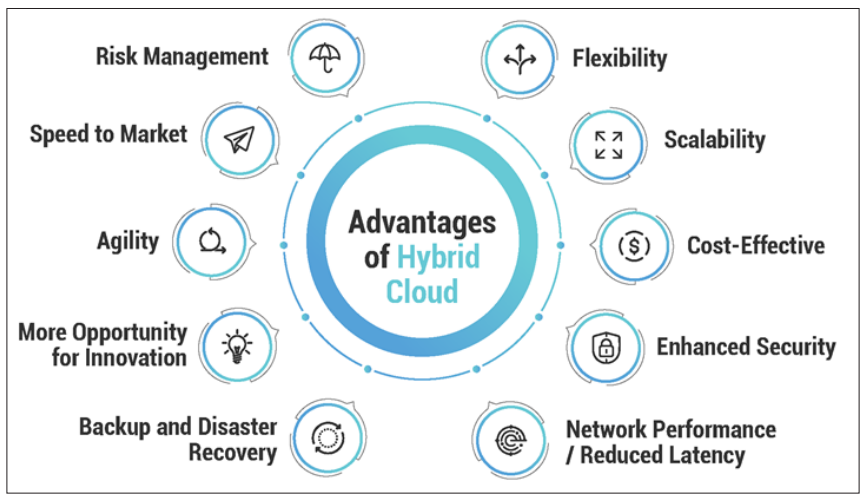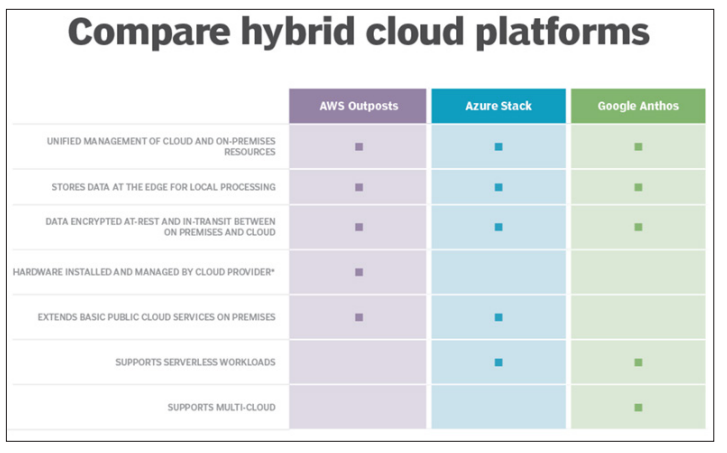Author(s): <p>Sreenu Maddipudi</p>
In today's rapidly evolving digital landscape, hybrid cloud strategies are becoming a critical solution for organizations in industries such as healthcare, finance, energy, and manufacturing. These sectors rely heavily on data security, regulatory compliance, and operational efficiency. The hybrid cloud model, which combines on-premise and cloud environments, offers a strategic solution to optimize performance, enhance security, and ensure scalability. This paper explores the benefits, challenges, and best practices of implementing hybrid cloud strategies in critical industries. It delves into how organizations can achieve maximum efficiency by balancing their existing on-premise infrastructure with cloud resources, ensuring business continuity, and optimizing cost management. Furthermore, the paper outlines key strategies for integrating on-premise systems with cloud platforms to enhance data security, operational flexibility, and compliance with industry regulations.
The hybrid cloud model is rapidly gaining traction across industries due to its ability to provide a balance between the control of on- premise systems and the scalability and cost-efficiency of cloud environments. A hybrid cloud approach enables organizations to run mission-critical applications and store sensitive data on- premises, while leveraging the cloud for dynamic workloads, analytics, and other non-critical functions. This approach is particularly important for critical industries such as healthcare, finance, manufacturing, and energy, where stringent regulatory requirements and high availability demands necessitate robust, scalable IT infrastructure solutions.
The combination of on-premise infrastructure with cloud resources offers significant advantages in terms of flexibility, data sovereignty, and disaster recovery. This paper aims to highlight how hybrid cloud strategies can be effectively employed by organizations in critical sectors to achieve maximum operational efficiency, minimize risks, and improve overall performance.

Simple overview of Hybrid Cloud
One of the key advantages of hybrid cloud strategies is the ability to scale computing resources dynamically, depending on business needs. Cloud environments offer virtually unlimited storage and processing capabilities, which can be scaled up or down as needed. Critical industries like healthcare and manufacturing, which experience fluctuating demands due to seasonal events, large-scale projects, or sudden data surges, can leverage this flexibility to improve operational efficiency. Organizations can store sensitive data on-premises while running computationally- intensive workloads in the cloud without sacrificing performance or security.
Critical industries often deal with sensitive data that must comply with regulations such as the Health Insurance Portability and Accountability Act (HIPAA), the General Data Protection Regulation (GDPR), and the Financial Industry Regulatory Authority (FINRA). A hybrid cloud strategy allows organizations to keep sensitive data within on-premise systems or private clouds, ensuring compliance with these regulatory frameworks, while benefiting from the advanced security measures of public cloud providers for less sensitive workloads.
By adopting hybrid cloud architectures, businesses can control which data resides in the cloud and which stays on-premises, reducing the risk of non-compliance and data breaches. Cloud platforms also offer robust encryption, access control mechanisms, and audit trails that can help organizations meet compliance requirements without sacrificing flexibility.
The hybrid model allows businesses to optimize costs by storing high-demand data in on-premise systems and less critical information in the cloud. For instance, the ability to offload certain non-core or legacy applications to the cloud can reduce infrastructure costs while maintaining control over mission-critical applications. Additionally, organizations can take advantage of the pay-as-you-go model offered by cloud providers, ensuring they only pay for the resources they need, when they need them.
Hybrid cloud strategies also help optimize IT resources by enabling organizations to avoid over-provisioning hardware or dealing with the costs of maintaining underutilized infrastructure. With this cost-optimization approach, businesses can allocate their IT budgets more effectively.
Business Continuity and Disaster Recovery: Hybrid cloud solutions provide robust disaster recovery options. Data can be replicated across multiple locations, ensuring that critical operations can continue even in the event of a disaster.

Define the goals and objectives of the hybrid cloud strategy. Identify which workloads are best suited for the cloud and which should remain on-premises.
Effective integration of on-premise and cloud systems is essential for hybrid cloud success. Critical industries need to ensure that data flows seamlessly between the two environments without disrupting operations. To achieve this, organizations must use integration tools that can connect on-premise systems with cloud platforms and ensure data consistency across environments.
API gateways that provide a bridge between on-premise applications and cloud services.
Middleware solutions to manage data flow, transforming it into formats that can be consumed by both environments.
Data virtualization technologies that provide a unified, real-time view of data from disparate systems.
By integrating their systems properly, industries can make sure that both their on-premise and cloud environments work together as a cohesive unit.
A key consideration when implementing a hybrid cloud strategy is ensuring robust security across both environments. Organizations must address several concerns:
Data encryption: Encrypt sensitive data both in transit and at rest, ensuring compliance with privacy and security standards.
Identity and access management (IAM): Use centralized IAM platforms to control access to both on-premise and cloud-based resources, ensuring only authorized users can access sensitive data and systems.
Multi-factor authentication (MFA): Enhance security by requiring multiple authentication methods to access critical systems.
Hybrid cloud security tools provided by cloud vendors, such as AWS Identity and Access Management (IAM) or Microsoft Azure Active Directory, can help organizations implement these security measures.
A critical concern in many industries is ensuring business continuity in the event of a disaster. Hybrid cloud strategies provide an effective disaster recovery (DR) model by allowing data to be backed up and replicated in the cloud, ensuring rapid recovery in case of system failure or data loss. Since cloud environments are geographically distributed, they offer a higher level of redundancy compared to traditional on-premise setups.
Automated backups: Scheduled backups to the cloud to ensure data is protected and recoverable.
Failover and replication: Replicating on-premise applications in the cloud, ensuring that operations can continue if an on-premise system fails.
Cloud-based testing: Using the cloud for regular testing of disaster recovery procedures without affecting on-premise operations. By utilizing the cloud as a backup for on-premise systems, critical industries can ensure minimal downtime and faster recovery from disasters.
Hybrid cloud environments can introduce complexity in managing different platforms, applications, and services. To overcome this, organizations should implement strong cloud governance and management practices to ensure resources are utilized efficiently and in compliance with regulations. Some key strategies include: Cloud management platforms (CMPs) that provide a unified interface for managing both on-premise and cloud resources.
Cost management and monitoring tools that help organizations track usage and optimize costs.
Compliance frameworks to ensure that data and applications comply with relevant regulations across both on-premise and cloud systems.
Platforms such as VMware vRealize, Microsoft Azure Arc, and AWS Outposts offer integrated solutions for managing hybrid environments, improving visibility, and control over all systems.

Train and Educate Staff: Provide ongoing training for IT staff to manage hybrid cloud environments effectively. This includes understanding cloud services, security protocols, and integration techniques.
While hybrid cloud strategies offer significant advantages, they also come with challenges:
Managing a hybrid cloud environment can be complex due to the need to integrate and orchestrate multiple platforms. Organizations must invest in tools and skills to manage these environments effectively
Ensuring seamless data integration between on-premise and cloud systems is a significant challenge. Organizations need to adopt standardized protocols and APIs to facilitate interoperability Security Risks
While hybrid clouds offer enhanced security, they also introduce new risks. Organizations must implement robust security measures, such as encryption and access controls, to protect data across different environments
Although hybrid clouds can be cost-effective, they require careful management to avoid unexpected expenses. Organizations need to monitor usage and optimize resource allocation continuously Despite these challenges, a well-planned hybrid cloud strategy can overcome these hurdles and deliver substantial benefits in terms of efficiency and business continuity.
Hybrid cloud strategies offer a powerful solution for critical industries seeking to combine the control of on-premise systems with the scalability and flexibility of the cloud. By adopting these strategies, organizations can ensure maximum efficiency, enhance security, meet regulatory requirements, and achieve cost optimization. However, a successful hybrid cloud implementation requires careful planning and robust management practices to integrate on-premise systems with cloud resources seamlessly. As businesses in sectors such as healthcare, finance, and manufacturing increasingly adopt hybrid cloud solutions, they will be better equipped to navigate the complexities of modern IT landscapes while ensuring business continuity and resilience [1-8].
